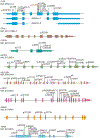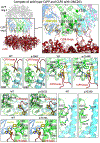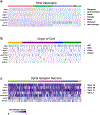New insights into Perrault syndrome, a clinically and genetically heterogeneous disorder
- PMID: 34338890
- PMCID: PMC11330641
- DOI: 10.1007/s00439-021-02319-7
New insights into Perrault syndrome, a clinically and genetically heterogeneous disorder
Abstract
Hearing loss and impaired fertility are common human disorders each with multiple genetic causes. Sometimes deafness and impaired fertility, which are the hallmarks of Perrault syndrome, co-occur in a person. Perrault syndrome is inherited as an autosomal recessive disorder characterized by bilateral mild to severe childhood sensorineural hearing loss with variable age of onset in both sexes and ovarian dysfunction in females who have a 46, XX karyotype. Since the initial clinical description of Perrault syndrome 70 years ago, the phenotype of some subjects may additionally involve developmental delay, intellectual deficit and other neurological disabilities, which can vary in severity in part dependent upon the genetic variants and the gene involved. Here, we review the molecular genetics and clinical phenotype of Perrault syndrome and focus on supporting evidence for the eight genes (CLPP, ERAL1, GGPS1, HARS2, HSD17B4, LARS2, RMND1, TWNK) associated with Perrault syndrome. Variants of these eight genes only account for approximately half of the individuals with clinical features of Perrault syndrome where the molecular genetic base remains under investigation. Additional environmental etiologies and novel Perrault disease-associated genes remain to be identified to account for unresolved cases. We also report a new genetic variant of CLPP, computational structural insight about CLPP and single cell RNAseq data for eight reported Perrault syndrome genes suggesting a common cellular pathophysiology for this disorder. Some unanswered questions are raised to kindle future research about Perrault syndrome.
© 2021. This is a U.S. government work and not under copyright protection in the U.S.; foreign copyright protection may apply.
Conflict of interest statement
Figures



Similar articles
-
Expanding the genotypic spectrum of Perrault syndrome.Clin Genet. 2017 Feb;91(2):302-312. doi: 10.1111/cge.12776. Epub 2016 Apr 1. Clin Genet. 2017. PMID: 26970254
-
Biallelic mutations in LARS2 can cause Perrault syndrome type 2 with neurologic symptoms.Am J Med Genet A. 2018 Feb;176(2):404-408. doi: 10.1002/ajmg.a.38552. Epub 2017 Dec 3. Am J Med Genet A. 2018. PMID: 29205794
-
Genomic sequencing highlights the diverse molecular causes of Perrault syndrome: a peroxisomal disorder (PEX6), metabolic disorders (CLPP, GGPS1), and mtDNA maintenance/translation disorders (LARS2, TFAM).Hum Genet. 2020 Oct;139(10):1325-1343. doi: 10.1007/s00439-020-02176-w. Epub 2020 May 12. Hum Genet. 2020. PMID: 32399598
-
LARS2-Perrault syndrome: a new case report and literature review.BMC Med Genet. 2020 May 18;21(1):109. doi: 10.1186/s12881-020-01028-8. BMC Med Genet. 2020. PMID: 32423379 Free PMC article. Review.
-
An Application of NGS for Molecular Investigations in Perrault Syndrome: Study of 14 Families and Review of the Literature.Hum Mutat. 2016 Dec;37(12):1354-1362. doi: 10.1002/humu.23120. Epub 2016 Oct 7. Hum Mutat. 2016. PMID: 27650058 Review.
Cited by
-
The prognostic role and metabolic function of GGPS1 in oral squamous cell carcinoma.Front Mol Biosci. 2023 Mar 24;10:1109403. doi: 10.3389/fmolb.2023.1109403. eCollection 2023. Front Mol Biosci. 2023. PMID: 37033446 Free PMC article.
-
Biallelic variants in DAP3 result in reduced assembly of the mitoribosomal small subunit with altered intrinsic and extrinsic apoptosis and a Perrault syndrome-spectrum phenotype.medRxiv [Preprint]. 2024 Aug 21:2024.08.19.24312079. doi: 10.1101/2024.08.19.24312079. medRxiv. 2024. Update in: Am J Hum Genet. 2025 Jan 2;112(1):59-74. doi: 10.1016/j.ajhg.2024.11.007. PMID: 39371131 Free PMC article. Updated. Preprint.
-
The ever wider clinical spectrum of RMND1-related disorders and limitedness of phenotype-based classifications.J Mol Med (Berl). 2023 Oct;101(10):1229-1236. doi: 10.1007/s00109-023-02356-x. Epub 2023 Aug 16. J Mol Med (Berl). 2023. PMID: 37584739 Free PMC article.
-
The Perrault Syndrome Mystery: A Case Report on Its Diagnosis in a 26-Year-Old Female.Cureus. 2024 Oct 1;16(10):e70648. doi: 10.7759/cureus.70648. eCollection 2024 Oct. Cureus. 2024. PMID: 39483604 Free PMC article.
-
A Homozygous Missense Variant in HSD17B4 Identified in Two Different Families.Mol Syndromol. 2024 Mar;15(2):143-148. doi: 10.1159/000534785. Epub 2023 Nov 14. Mol Syndromol. 2024. PMID: 38585549 Free PMC article.
References
-
- Baes M, Huyghe S, Carmeliet P, Declercq PE, Collen D, Mannaerts GP, Van Veldhoven PP (2000) Inactivation of the peroxisomal multifunctional protein-2 in mice impedes the degradation of not only 2-methyl-branched fatty acids and bile acid intermediates but also of very long chain fatty acids. J Biol Chem 275:16329–16336. 10.1074/jbc.M001994200 - DOI - PubMed
Publication types
MeSH terms
Substances
Supplementary concepts
Grants and funding
LinkOut - more resources
Full Text Sources
Miscellaneous

